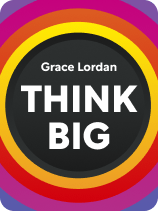

This article is an excerpt from the Shortform book guide to "Think Big" by Grace Lordan. Shortform has the world's best summaries and analyses of books you should be reading.
Like this article? Sign up for a free trial here.
Are you lazy, unskilled, or hard to get along with? How can you prove yourself wrong about any of these beliefs?
Behavioral science expert Grace Lordan urges you to make and implement a plan to transform yourself into the person you want to be. She discusses how to recognize and address internal obstacles by getting confident about your abilities and potential.
Read on to learn how to build up confidence in yourself and your dreams.
How to Build Up Confidence
Lordan suggests that, in order to confidently pursue the actions necessary to become your ideal self, you must overcome the personal stories that are hindering your progress. We all have stories that we tell ourselves about who we are. And, thanks to confirmation bias, we pay attention to any evidence that confirms these stories and ignore anything that contradicts them. But, some of these stories might prevent you from pursuing your goal. So, you must learn how to build up confidence by dispelling the stories that aren’t (or don’t have to be) true.
For example, you might tell yourself, “I’m too old to change my routine.” Identify these limiting stories by examining the anxieties that arise when you refuse a potentially advantageous situation. Then, identify any actions you might take to disprove this story and create a new one. For example, you might believe, “I’m a couch potato.” Signing up for an exercise class and regularly going to the gym will prove that you’re not a couch potato and help you develop a new story that you’re someone who exercises regularly.
| How Lordan’s Advice Compares to James Clear’s In Atomic Habits, James Clear agrees that you must transform the stories that you tell yourself in order to change your behavior long-term. Moreover, he asserts that this is the only effective way to transform your habits. Most of us try to change our behavior using goal-driven habits: We perform a behavior to reach a specific goal. However, once we reach that goal, we lose the motivation to keep performing that behavior. Instead, Clear recommends that we develop identity-driven habits: behaviors we perform because they match the stories we believe about who we are—in other words, our identity. To do so, we must identify the type of person we want to be (our ideal self), then behave like that person. Eventually, we’ll gather enough evidence to truly believe we’re that person, and we’ll perform the behavior because it’s part of our identity. This is clearly a case in which you can use confirmation bias to your advantage, although Clear doesn’t use that term: You’re paying attention to evidence that you are your ideal self because it fits in with the story you’re telling yourself, and you’re ignoring any evidence that you’re not that person. |
Confidently pursuing your goals also requires that you put yourself out there. Lordan explains that we often don’t take potentially risky actions (like chasing our goals) due to anticipatory loss aversion: We expect any potential failures to feel worse than any potential success. We may also refuse to act due to how badly we expect others to react to our failure—a cognitive bias known as the saving face effect. But in reality, we tend not to feel as badly as we expect to when we do fail. Moreover, since we suffer from a spotlight effect that makes us think people are paying more attention to us than they actually are, people tend not to judge us as badly as we expect them to. Reminding yourself of these realities can help you put yourself out there.
| Reframe Your Fears If you struggle to chase your goals because you’re worried about how failing might feel or how others will react to a potential failure, you’re acting out of fear. But what if your awareness of these cognitive biases or of the reality that people aren’t paying as much attention to you as you think doesn’t help reduce your fear or motivate you to act? In Everything Is Figureoutable, Marie Forleo recommends reframing your fear as a good thing. As she points out, if you’re afraid to do something, it’s often a sign that you care deeply about it—and so you should do it. To determine exactly what your fear is telling you, Forleo recommends the following exercise: First, relax your body by taking several deep breaths. Then, ask yourself whether doing the thing that scares you makes you feel open or closed off—and pay attention to how your body reacts. If you feel enthusiastic and like a weight has been lifted, that’s a good sign. If your muscles tense and you feel nauseated, consider holding off. |

———End of Preview———
Like what you just read? Read the rest of the world's best book summary and analysis of Grace Lordan's "Think Big" at Shortform.
Here's what you'll find in our full Think Big summary:
- Why most of our attempts to transform our lives fail
- How to overcome the cognitive biases that hold us back from our goals
- How to take the necessary small steps to change your life long term






